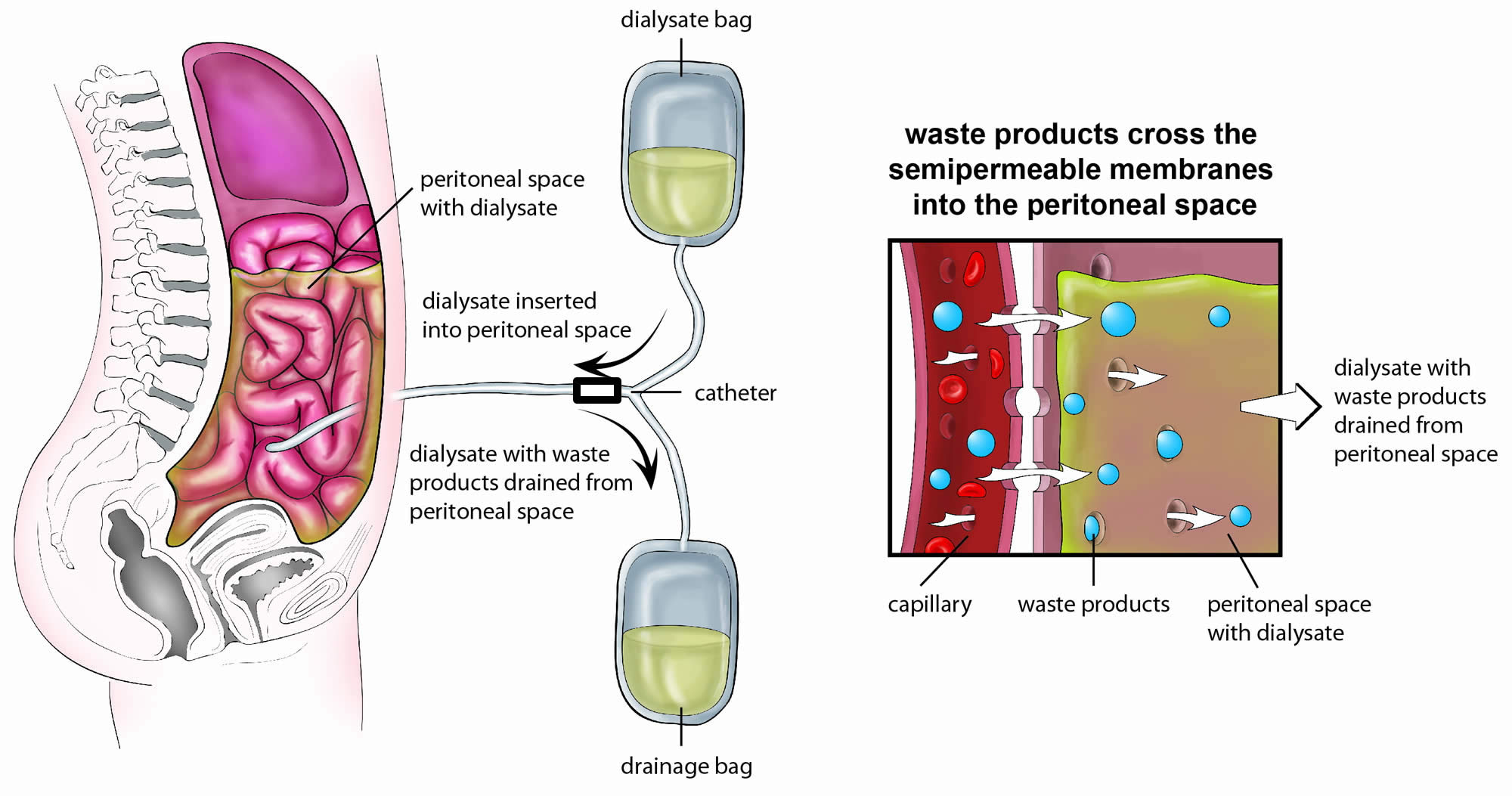Peritoneal Dialysis Background
Peritoneal dialysis differs from hemodialysis as it is done through the peritoneum (lining of the abdomen) rather than through the blood. Surprisingly, peritoneal dialysis as a treatment began much earlier than hemodialysis, however, there were complications with accessing the perineal cavity-causing treatment to take a pause. Peritoneal dialysis was first introduced in the 1920s and was further developed in the 1960s with the development of intermittent peritoneal dialysis. The development of this was conducted in three locations; Seattle under Henry Tenckhoff; Montpelier, France under Charles Mion; and in Toronto. Peritoneal dialysis was further developed due to patients that were not able to undergo treatment of hemodialysis and gave more options for patients with ESRD. The development of peritoneal dialysis is important as it gives patients control over their disease.
It is important to note that there are two kinds of peritoneal dialysis. There is Continuous Ambulatory Peritoneal Dialysis (CAPD) and Continuous Cycling Peritoneal Dialysis (CCPD). There are both advantages and disadvantages to each kind and patients will choose whatever fits better into their lifestyle.
In order to begin peritoneal dialysis, a catheter is placed in the peritoneal cavity in a minor surgical operation. This provides a small opening in the abdomen in which dialysis fluid can enter and exit. When the dialysis fluid is entered into the body, the peritoneal membrane acts as a filter. The sugar in the dialysis fluid works as a magnet and pulls from waste and unneeded fluids from the blood into the dialysis fluid in the peritoneal cavity. Dextrose, a type of sugar similar to blood sugar, is in the dialysis fluid and the strength of dextrose in the dialysis fluid varies from patient to patient. The strength of dialysis fluid used is specially prescribed for each patient based on their weight and blood pressure. The cycle of draining and refilling the fluid from the peritoneal cavity is called an "exchange". Depending on the person, one might do more or fewer exchanges each time they perform dialysis.
There are two kinds of peritoneal dialysis. We will first cover Continuous Ambulatory Peritoneal Dialysis (CAPD). CAPD is continuous and the dialysis process never stops. The dialysate is inserted into the peritoneal cavity and allowed to remain and filter and later emptied. Gravity moves the dialysate through the catheter into and out of one's body. APD is convenient as the patient is not attached to a machine during treatment. Typically, CAPD patients will do exchanges when they wake up in the morning, at lunch, at dinner, and before going to bed. The exchanges can be done anywhere that is clean, i.e., work, home, etc. CAPD gives patients the freedom to enjoy everyday activities and supplies can be easily packed up in a tote bag for exchanged away from home.
Continuous Cycling Peritoneal Dialysis is dialysis performed at home with a peritoneal dialysis cycler machine. Before going to sleep, a tubing set is attached to the bags on the machine. The catheter is connected to the tubing and the cycler machine will perform several exchanges through the night. The tubing is long enough to walk several feet and sleep comfortably. The machine has three jobs: to heat the dialysis fluid to body temperature, control the timing of each exchange, and monitor aspects of the treatment. If something were to go wrong during treatment, an alarm would sound and safety precautions are built-in.
The risks of peritoneal dialysis are infection from the catheter, weight gain, hernia, or inadequate dialysis. Each person is different and one form of dialysis may fit into a person's lifestyle better than the other.
The image describes peritoneal dialysis and how the dialysate enters the peritoneal cavity. Dialysis is able to occur.
Sources:
Mehrotra, R., Devuyst, O., Davies, S. J., & Johnson, D. W. (2016). The Current State of Peritoneal Dialysis. Journal of the American Society of Nephrology: JASN, 27(11), 3238–3252. https://doi.org/10.1681/ASN.2016010112
Patient Manual [Leaflet]. (2019). Dialysis Clinic, Inc.
Peritoneal Dialysis. (2021). Mayo Clinic. https://www.mayoclinic.org/
tests-procedures/peritoneal-dialysis/about/pac-20384725


Comments
Post a Comment